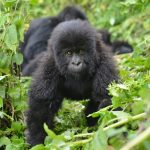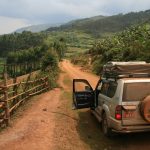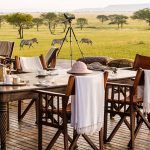Migration Safari and Gorilla Trek: Fly-In Safaris Experience

Tanzania and Uganda offer one of the best classic Tanzania Uganda Safari – 10 Day in Africa especially if timed with the annual wildebeest migration. Tanzania is one of Africa’s top safari destinations. The wildlife viewing is out of this world and big cats are especially easy to see. Home to nearly half of the world’s remaining mountain gorillas, Bwindi Impenetrable National Park is a thrilling destination.
About 459 gorillas live in the steep mountain jungle and several groups have been habituated to humans. An up-close encounter with these critically endangered giants is an experience like no other and anyone who has the chance shouldn’t pass up the opportunity.
The Tanzania northern safari circuit takes in the world-renowned Serengeti migration, exclusive Grumeti, iconic Ngorongoro Crater, elephant-rich Tarangire, Africa’s highest mountain Kilimanjaro, and scenic Lake Manyara. These diverse attractions make for an incredible safari itinerary in a wildlife-rich region synonymous with natural beauty and animal sightings of the highest order.
You can start with either Tarangire National Park or Lake Manyara National Park before spending three days in the Serengeti National Park following the movements of the wildebeest migration. You’ll then finish your drive in the Ngorongoro Conservation Area, then fly to Uganda’s Bwindi Impenetrable National Park. There’s no better way to see the 2023 wildebeest migration in action and see the amazing parks that have made Tanzania and Uganda so famous.
Tarangire National Park
Tarangire National Park should be on any itinerary of northern Tanzania in the Dry season. At this time the Tarangire River, the lifeline of the park, acts as a magnet for big herds of thirsty animals, such as zebra, eland, wildebeest and giraffe. Most notable though are the elephants. Massive herds move around the park, and in the heat of the day, they all descend to the waterways. Predators tend to follow this migration and the park is literally teeming with wildlife from July to October.
The elephant viewing in Tarangire is truly astonishing. It is far from unusual to see more than a dozen matriarchal herds, comprising a few hundred individuals in total, over the course of a single game drive. Tarangire is a great ornithological destination, with more than 550 bird species recorded often perform their outrageous clockwork duet on the red termite mounds where they nest.
Lake Manyara National Park
Still about the northern circuit is the Lake Manyara National Park, one of Tanzania’s most scenic parks. The lake shore with its floodplains gives way to acacia woodland below the steep walls of the Rift Valley escarpment. As you enter the park, you will find yourself in lush groundwater forest.
Lake Manyara is famous for its tree-climbing lions. Another draw is the big elephant population with massive tuskers, which tend to be particularly relaxed here. The park’s other claim to fame is the opportunity to see flamingos.
Don’t miss out on the treetop walkway at the park’s entrance. The 370m-/1,200ft-long air walk takes you through the forest canopy at a thrilling height of 18m/60ft. This unique opportunity to get a bird’s eye perspective of the forest is more than worthwhile. The entrance area of the park gets very crowded with day visitors arriving mid-morning or in the afternoon. Therefore, the best time to visit is very early in the morning.
Serengeti National Park
What can be said about Serengeti National Park that hasn’t already been said? This is simply Africa as you always imagined it. Endless rolling bleached grasslands with scattered flat-topped acacia trees and animals everywhere. This is the Tanzania’s mirror image of Kenya’s Masai Mara and it’s physically much the same but on a much larger scale. According to the many things to see in this park, you can spend 3 to 4 days admiring what Serengeti has to offer.
The headline event is the annual wildebeest migration, and being able to witness a part of this which takes both planning and luck is an unforgettable experience. The Serengeti is also known for its high density of predators, and the chance to watch lions and other cats – often at very close range, is another treat.
Lions are abundant in the Serengeti, and often seen in prides numbering 15–25 individuals. The solitary cheetah is very common in certain areas, particularly in the south, while the central Seronera Valley is one of the most reliable sites in Africa for leopards in recent years, it has also become a good place to look for tree-climbing lions.
Above all, Serengeti offers the singular thrill of encountering the world’s greatest annual animal migration, consisting of some two million bleating wildebeest, together with a supporting cast of zebra, gazelle, eland, hartebeest and predatorily hangers-on such as hyena, vulture and jackal.
Shorter safaris concentrate on the well-visited central Serengeti. With more time and depending on the season, but I’d also recommend spending at least part of your Serengeti itinerary in the western corridor around the Grumeti River or in the far north.
Balloon safaris are a popular add-on to the Serengeti experience and, in one of the most exciting recent developments in the safari world, walking safaris and bush camping are now allowed here, albeit on a limited scope.
Ngorongoro Crater
Ngorongoro Crater is one of the largest unbroken calderas in the world, and the view from above is one of the most stunning vistas in Africa. It’s one of the few places I have visited where seeing pictures or video before seeing the real things did nothing to diminish the magic of the moment. But, it’s not the scenery that makes Ngorongoro the most visited destination in Tanzania, it’s the unrivalled abundance of wildlife inside the crater; in particular predators, for which this is the highest density of any single spot in Africa.
Even more thrilling is the high likelihood of seeing black rhino. This would make for a relatively easy Big Five day if it weren’t for the fact that Ngorongoro’s leopards mostly stick to the forested fringes of the crater and are rarely seen. From a safari standpoint, the rest of the Ngorongoro Conservation Area is pretty much just what you have to pass through on the drive to Serengeti National Park, except for the January to March migration season, when the famous herds of wildebeest, zebra, Topi, eland and more roam down the conservation area’s western edge. But besides wildlife, Ngorongoro is an excellent trekking destination and also home to over 40,000 Masai, plus the Olduvai Gorge, where many important fossils of early human ancestors have been found, cuts across the west.
Arusha Auric Air Tanzania to Entebbe Uganda
After breakfast your guide will transfer you back to Arusha Airport for your flight to Entebbe with Auric Air connecting to Entebbe Airport in line with Aero link Uganda. On arrival, meet and great by our company representative and late he will transfer you to your accommodation in Entebbe. Early morning after breakfast, you will be picked and transferred back to Entebbe Airport through Aero link Uganda for your flight to Kihihi Airstrip where the company driver will be ready on ground to meet you and transfer you to Queen Elizabeth and Bwindi Impenetrable National Parks.
Queen Elizabeth National Park
Despite this being Uganda’s most well-known and regular visited wildlife area, it is far from overcrowded. Queen Elizabeth offers amazing diversity in small area. The Kasenyi plains are a good place to start for Savannah animals. These plains below the Mountains of the Moon are dotted with Uganda kobs and lions lurk around every corner preying on these abundant snacks. The Mweya Peninsula site of the most established of several dozen lodges set in and around the park, is the base for boat trips along the lovely Kazinga channel.
The best way to get an early feel for Queen Elizabeth National Park is to join the two-hour boat cruise up the Kazinga channel which runs between Lake George and Lake Edward. Bird life is fantastic but the whole journey, especially if you go at sunset, is filled with sightings of watering elephants, buffalo, hippos, crocodiles and various antelopes. A definite highlight of the area is a walking safari in Kyambura Gorge where you can see several primate species with undoubtedly the most spectacular being chimpanzees.
Queen Elizabeth to Bwindi Impenetrable National Park
You transfer to Bwindi via Ishasha sector, a remote wilderness area where you will encounter tree climbing lions. Next destination, Bwindi Impenetrable National Park home to the mountain gorillas. Uganda is one of only three countries in the world where mountain gorillas can be reliably tracked on foot. Gorillas in Bwindi can be tracked in the four trailheads, Buhoma, Ruhija, Nkuringo and Rushaga. Yet, while the opportunity to stare into the liquid brown eyes of a giant silver back is what brings most tourists to Bwindi.
Gorilla Trekking in Bwindi Impenetrable Forest
The gorilla safari is led by experienced gorilla trackers on the slopes of the forest. Although the hike can be physically demanding, the anticipation of the exciting experience ahead is amazing. The beauty of the gorilla forest and its inhabitants are fascinating. One of Africa’s major highlights is when you encounter these gentle apes. It is a humbling experience to stand just meters from man’s distant cousins as they eat rest, play and bond with their young ones.
Do not forget to carry your rain gear, packed lunch, plenty of water, gloves, hat, and a waterproof bag for protection of your camera in case of rain. After early morning breakfast, drive back to Entebbe to catch your late-night flight to your onward destination.





0 Comments